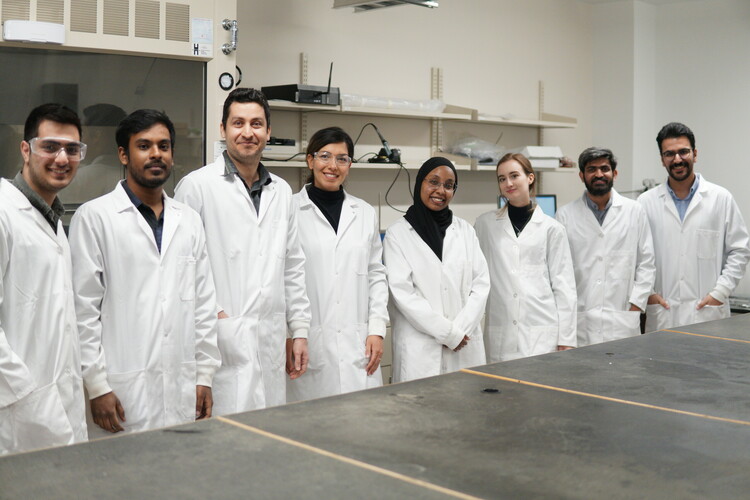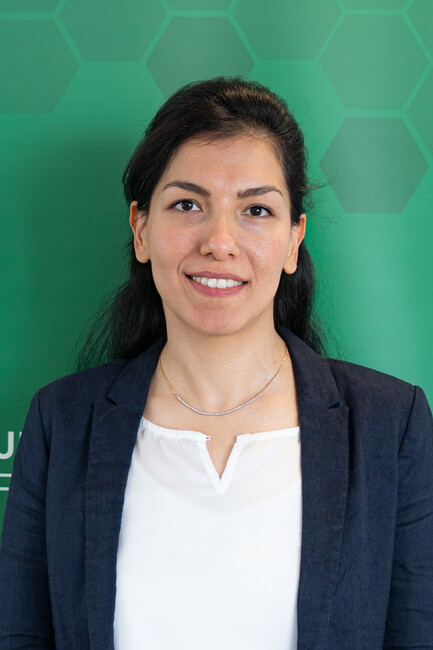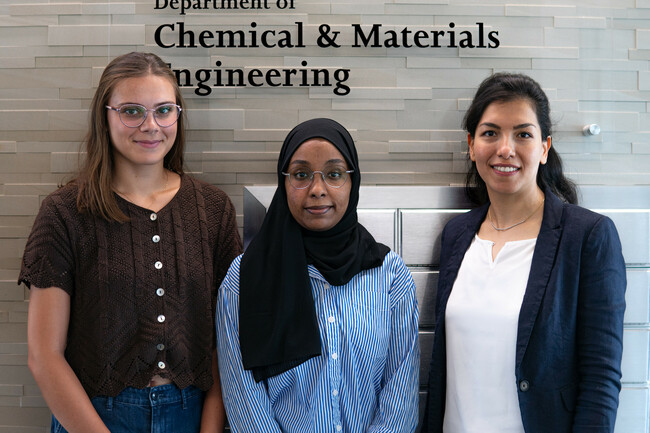Catalyzing Green Hydrogen Research at the U of A
Posted on
Dr. Mohajernia's 2024 Research Team
Catalyzing Green Hydrogen Research at the U of A
Dr. Shiva Mohajernia began her professional engineering career at the University of Erlangen-Nurenberg in Germany. Her doctoral research and post-doctoral work centred on catalysis for hydrogen production. When the time came to expand her academic career, her heart was set on continuing her work in the renewable energy sector, and she became a team leader at the Chemistry & Structure of Novel Materials Institute in Germany.

When it came to choosing her first appointment, the University of Alberta (UofA) was one of her top contenders; Alberta’s unique history of energy production, specifically in oil and gas, positioned it as a world-leading energy centre with remarkable talent, funding opportunities, and top-of-the-line facilities. With access to the Edmonton Region Hydrogen Hub and a growing hydrogen industry offering a wealth of opportunity, Shiva selected Edmonton as home.
Since January 2023, Shiva and her growing team of engineers in the UofA’s Chemical and Materials Engineering Department have been looking into new and alternative materials for catalytic hydrogen production. Her research advocates for green hydrogen efforts at a more affordable rate using energy-efficient artificial photosynthesis.
Because of its historical ties with oil and gas, Alberta commonly implements grey and blue hydrogen production, meaning hydrogen and carbon monoxide are byproducts of an endothermic reaction—a reaction that absorbs heat—between water vapour, methane, and a catalyst. Blue hydrogen differs from grey because it employs tandem carbon capture, utilization, and sequestration practices that decrease overall carbon emissions.
The province is also supporting opportunities for green production. These methods utilize electricity from renewable energy resources like wind and solar, to split water molecules into hydrogen and oxygen. However, the electrolyzer materials that perform this function are often composed of costly noble metals, creating a barrier to green hydrogen production becoming common practice. That’s the gap Shiva’s research aims to fill.
Instead of noble metals, Shiva’s team is trying out semiconductor metal oxides. These semiconductors are decorated with single-atom, bi-atom, or multi-atom co-catalysts. Her team discovers, analyzes, and synthesizes new designs for the catalysts in order to improve the water-splitting abilities of artificial photosynthesis units. So far, the results of Shiva’s research have demonstrated superior performance to the conventional nanoparticle-decorated substrates.
Despite the journey of re-establishing a career in a new city, Shiva has found plenty of support at the University through friends and colleagues, and in the broader Edmonton community. Over the past year and a half, she has established groundbreaking renewable energy research and quickly secured partnerships with Alberta’s hydrogen industry players. She set up her lab and has grown her research team to six graduate students. And this past January, she also began teaching materials engineering to undergraduate students.

“It’s been challenging at times, but it’s also been rewarding,” says Shiva. “I’m really enjoying teaching—the students are so polite and eager to learn. Alberta’s talent reputation was one of the reasons I chose the UofA, and now I get to experience it firsthand. I see what the hype is about.”
Shiva has settled well into Edmonton and appreciates living in Alberta. She’s especially excited about the diversity of energy resource opportunities here:
“Alberta is so spoiled for energy resources, “ Shiva says. “Yes, oil and gas is a big part of that, but Alberta also gets the most sun in Canada so it’s great for solar energy. There’s windy parts of Alberta and geothermal potential, too. Of course, Alberta is also positioning itself as a leader in hydrogen production.”
Compared to Germany, she has found less public engagement when it comes to renewable energy in Alberta. However, Shiva is looking forward to more opportunities to share her knowledge and research:
“In Germany, we hosted campus tours for the public,” Shiva recalls. “It was a chance for people to learn and ask questions about their own energy use and how our research is building toward a greener and more sustainable future.
“My favourite was sharing the inspiration for the future I envision. It’s a quote by Thomas Edison. He said, ‘In the future, electricity will be so cheap that only the rich will burn candles’. Well, in our future, hydrogen will be so cheap that only the rich will burn fossil fuels.”
Shiva will be sharing her hydrogen work with Edmonton’s public audiences on June 19th, 2024 with the presentation, “What do we know about green hydrogen?” The public talk is part of Future Energy System’s ongoing series Energy Talks with the Edmonton Public Library - Strathcona Branch. For more information or to register for Shiva’s talk, click here.
Further readings:
What in the (geological) well is carbon capture?: News - Future Energy Systems.
Why Hydrogen: Edmonton Region Hydrogen Hub